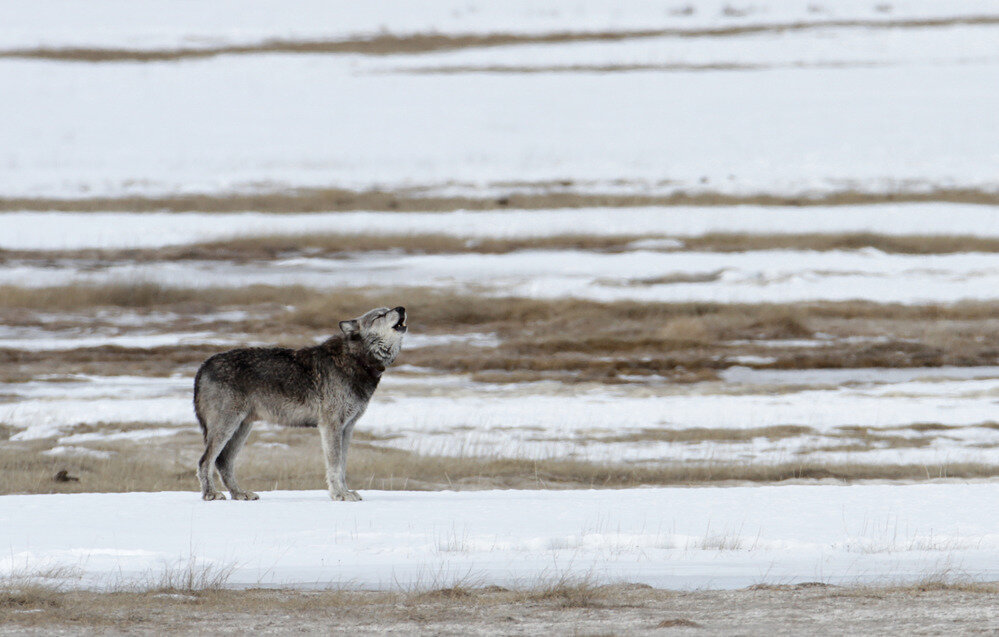What do wolves do in the winter?
By Tom Mallon
The weather is beginning to warm, but it was a rather cold winter this year in Montana. Just a few weeks ago, the temperature hit –33°F in Yellowstone National Park, and the average low temperature at night during the month of February was 0°F. The few park roads near the North Entrance that remain open all year round were closed for days at a time due to severe winds and blowing snow. At times, the Northern Rocky Mountain landscape seems much too harsh to support any form of life.
While bears are tucked away in their dens for the winter, wolves do not hibernate to escape the frigid temperatures, remaining active regardless of the brutal weather. The temperatures may seem inhospitable, but wolves do quite well in the winter. It’s actually the warmer temperatures that can sometimes be hard for them to handle, but that’s a story for another day.
Wolves are equipped with a double coat of fur, which allows them to endure temperatures as low as –40°F. Their undercoat is made of short hairs that are so thick the U.S. military once used them to line soldiers’ parkas, a practice that was outlawed in the 1970s.
The outer guard hairs are much longer and protect the undercoat from permeating moisture. Wolves have almost no body-heat loss, a feat demonstrated by the fact that snow will not actually melt on a wolf’s fur. They also have special blood vessels in their toes that keep their furred footpads just above the freezing point, preventing the buildup of snow and ice between their toes. During the coldest nights, a wolf will curl itself into a ball, covering its nose with its tail, which will hold the exhaled warm air over its feet and nose, conserving precious body heat. It will also sleep close to its pack mates in a unified effort to stay warm.
Special blood vessels in wolves’ feet are designed to keep furred footpads warm and prevent the buildup of snow and ice between toes.
Deep snow in the winter can make hunting challenging for wolves, though they have a great ability to adapt to changing conditions. It’s also the time of year when their prey are weakest since grazing opportunities for ungulates are limited, giving wolves a slight advantage.
When the pack goes on a hunt in the deep snow, it will follow the path of least resistance to conserve energy—the alpha male in the lead, with the rest of the adults and yearlings in tow. They follow old game trails, frozen lakes that have been cleared of snow, and ridgelines. They may travel up to 50 miles in one day in search of food, though it is more common in the winter for them to travel somewhere in the range of 15-25 miles per day
Wolves sense of smell, about 100 times stronger than that of a human, is so strong that they can detect and recognize the scent of a prey animal up to 1.75 miles away.Their sense of hearing is also something on which they rely to find prey; wolves can hear up to 10 miles away in the open and 6 miles away through wooded areas. Once they find an animal to stalk, they’ll stay upwind and remain out of sight as long as possible.
As they make their break for the prey animal, wolves’ wide feet act like snow shoes and help to keep them afloat on deep snow. Ungulates’ hooves have much less surface area and pierce through the snow, making it difficult for them to escape a quickly approaching wolf pack. Wolves can run at speeds up to 35mph and their jaws have a crushing pressure somewhere in the range of 1,500 pounds per square inch. For comparison, a full grown male German Shepherd has a bite of about 750 pounds per square inch. Wolves’ 42 teeth interlock so that they can hang on to the struggling prey. Once a bigger prey animal has been killed, the pack may stop for a few days to feed, but generally they continue moving, covering their home territory that ranges from 25-150 square miles.
As the temperatures warm and spring snow melts, bears are beginning to emerge from their dens, just in time for female wolves to settle into their newly inhabited dens and give birth to their pups. They’ll spend about 8-12 weeks in the spring den as they raise their pups from just 1 pound at birth to 30 pounds 3 months later, and then emerge into the warm summer air—quite the change from the bitter cold the pack experienced just a few short months ago.
A special thanks to the National Park Service for providing the photo for this blog post.



